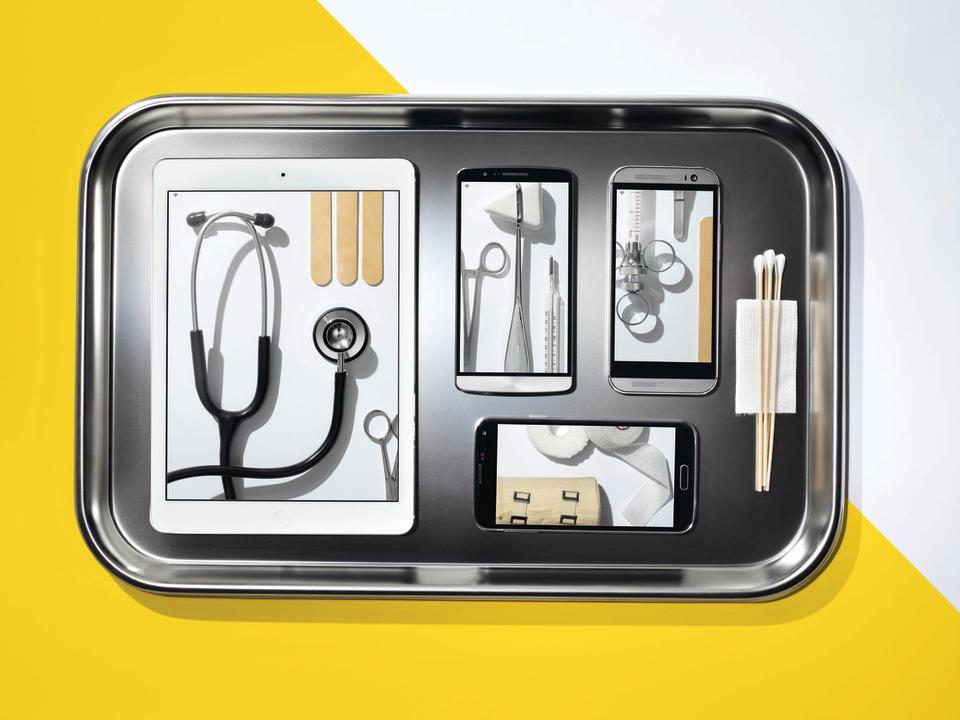What Everyone Should Know About the Telehealth Trend

Getting to the nearest high-risk pregnancy specialist was an ordeal for Tara Perez, a 35-year-old with type 1 diabetes. Tara lives in Cartersville, GA, a small town that can be up to three hours from Atlanta during rush hour. Because of her condition, it was critical for her to see this doctor regularly.
Fortunately, Tara’s local ob/gyn teamed with an Atlanta telehealth company, so every few weeks when she went for her checkup, she was also able to video-chat with maternal-fetal doctor Anne Patterson, M.D. “It was weird the first time I saw Dr. Patterson on the computer screen,” Tara says, but once she adjusted to the idea, “there were no disadvantages to not being in her office.” Her ob/gyn performed her basic exam, then conducted a special ultrasound that Dr. Patterson could immediately review. Skipping the long-distance drive meant that the appointments didn’t take much time away from Tara’s home fragrance consulting business. Most important, it allowed her to have top-notch medical care. She delivered her healthy baby girl, Selene, in her preferred local hospital last year.
The ability to offer specialty medical care outside of a big city is a key reason that telehealth (sometimes called telemedicine) has taken off in recent years. Approximately three-quarters of Georgia’s 20 maternal-fetal specialists, for example, are in Atlanta, says Tanya Mack, president of Women’s Telehealth, the company Tara’s doctor used. What’s fueling the surge: increased access to health care and improvements in technology, such as a secure flow of information. These allow health care providers to do things they couldn’t 25 years ago, like get near-instantaneous results for ultrasounds, EKGs, and other tests, says Mei Kwong, executive director of the Center for Connected Health Policy, a nonprofit research and policy organization in Sacramento, CA. Research has found that for many conditions, telehealth offers largely comparable results to in-person care, adds Kwong.

What a virtual appointment is like
Last year, some 7 million Americans accessed a doctor via a screen. The number of these live video appointments grew sixfold from 2015 to 2018, according to Rock Health, a fund that invests in health technology companies, and is expected to keep rising. About one in seven doctors now works in a practice offering telehealth, according to a December 2018 article in the journal Health Affairs. At the same time, stores like Walgreens, Rite Aid, and CVS are starting to offer urgent-care video link-ups in some locations.
While insurance reimbursements for remote treatment vary from state to state and plan to plan, some 96% of large companies offer a telehealth benefit to employees. In cutting-edge hospitals, doctors can easily consult with off-site specialists, and nurses can check on recently released patients, heading off costly readmissions.
Patients who have established relationships with doctors or therapists may prefer to download an app to talk to them rather than fight for an appointment. For other patients, the key is saving time—and not missing out on earnings to head to an in-office appointment. When Rebecca Garay, 35, of Miami felt the telltale pain and burning of a urinary tract infection at 4 a.m. one day last year, the personal trainer feared that she’d have to cancel all her clients and camp out at an urgent-care facility to get the antibiotic prescription she knew from past experience she needed. Then she remembered reading in an online moms’ group about a local hospital’s 24/7 app. While her husband and two kids slept, Rebecca downloaded Baptist Health’s Care On Demand app and answered a few questions about her symptoms and history. Within minutes, a doctor appeared on her screen. “I looked like a hot mess, but he didn’t care,” says Rebecca. They discussed her symptoms, which clearly indicated a UTI, and he sent the Rx to a local pharmacy. At $59 for the five-minute visit (the app doesn’t take insurance), Rebecca says it was worth it. “I thought it was very reasonable, especially when compared to a copay plus all the aggravation of going to a doctor,” she says.
Beyond convenience, research shows that telehealth can be as effective as in-person doctor visits. When 50 multiple sclerosis patients in a University of California study saw a new-to-them neurologist via video, all said their appointment satisfied their goals (e.g., understanding test results or adjusting meds), and three avoided a trip to the ER because the doctor was able to assess and treat them remotely. Other studies of televisits for rehab, mental health, and dermatology have shown results largely similar to those of in-person care.

When technology isn't enough
Of course, there are situations in which telehealth is not appropriate. If you’re having an asthma attack or a cardiac emergency, for example, you should head to the ER, and some less dire conditions are also better diagnosed in person. Although telehealth is used successfully in dermatology, one review found that cancerous lesions were more accurately flagged in a doctor’s office. And a Harvard study of people with acute respiratory infections who used a teledoc service found that while they were prescribed antibiotics at the same rate as patients visiting offices, they required more follow-up care. In some remote situations, both physicians and patients may find the distance hard to bridge. “If someone we’ve been helping loses a pregnancy, the doctor can’t reach through the camera to give them a hug,” Mack says.
Another limitation: Telemedicine requires access to sometimes expensive technology, including a camera, a monitor, and a secure network as well as specialized equipment like Bluetooth stethoscopes and remote ultrasound connections that may be out of reach for some smaller practices and hospitals.
Is telehealth the future?
With access to the technology and a little practice, though, doctors say they can usually give their patients what they need. Instead of bedside manner, “we call it ‘webside manner,’” says David Mishkin, M.D., medical director of Baptist Health’s telemedicine program. This involves making eye contact and being an especially good listener, as patient descriptions of symptoms may be all the doctor has to go by, he says. “Doctors are beginning to see that this is part of the future for improving access and expanding the delivery of health care,” Dr. Mishkin says. If it offers patients quality care at an affordable price, it’s a future we can all embrace.
This article was originally published in the October 2019 issue of Prevention.
Like what you just read? You’ll love our magazine! Go here to subscribe. Don’t miss a thing by downloading Apple News here and following Prevention. Oh, and we’re on Instagram too.
You Might Also Like

